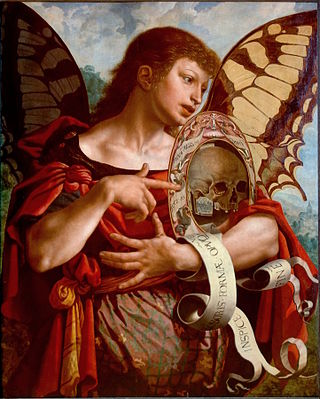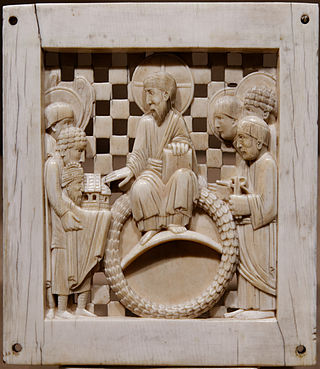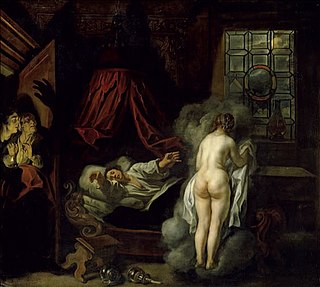Description
The painting is derived from the story in Matthew 17:24-27 which recounts Jesus asking the apostle to go to the lake at Capernaum to throw out his line and open the mouth of the first fish he would catch. Jesus assures Peter he will find a four-drachma coin in the fish's mouth. The coin was needed to pay the local temple tax, which every Israelite was required to pay to the temple in Jerusalem. The Gospel story does not itself recount the story of Peter following up on Jesus' instruction and catching the fish. [4]
Jordaens has depicted the biblical scene as an event occurring in 17th-century Flanders. The composition shows two groups of people: on the left people are on a ferryboat which is setting off and on the right is a group with a man (Saint Peter) pulling a fish from the water and looking at the coin he has found in its mouth. Only the apostles on the right surrounding Peter are concerned with him and his find. All passengers on the ferry are just minding their own business and do not pay any attention to the miraculous find that is occurring on the jetty. The gunwale of the ferryboat is only just clear of the water as the boat is heavily loaded with animals and passengers of all ages and nationalities. Within the group on the boat can be distinguished a man hoisting the sail and another one pushing the boat from the jetty with an oar. They are stocky, muscular men solely wearing loincloths. Behind them watching their work and huddled together are several persons, one of them a child crying because his apple has fallen into the water. [2] The group on the boat includes an African man, possibly a trader, in an exotic turban and with a white horse. The sky is covered with dark clouds. It must be windy as there are high waves on the river and a boat in the distance seems to be struggling. Two persons on the ferry are holding the rims of their hats to prevent them from flying away as the boat violently sets off. The scene on the boat with its lively crowd is the centre piece of the composition. It overshadows the scene on the right which is being watched from the boat by a peasant leaning on his cow. He is the only one who is not affected by the violent jerk, because he is witnessing the miraculous event on the jetty. He is looking at the large coin which a swarthy fisherman holds in his hand after finding it in the mouth of a large fish which he is still holding with his other hand. This almost naked fisherman is sitting on the jetty while four men who are no different from the rest of the people in the boat, either, are bending over him to see the coin, with expressions of amazement. [1]
The painting is a very decorative piece, with figures who are clearly distinguished in character and posture. The groups are well composed and connected. The scene is lively and full of movement. The brushwork is rather superficial and the light and palette are varied and harmonious. [2]
Amsterdam version
Jordaens also painted a smaller version (119 x 197.5 cm) of the same bible story which is in the Rijksmuseum in Amsterdam. The painting, likely painted in the 1630s or early 1640s, is no preparatory sketch or a repetition of the earlier work, but rather an adaptation of the same subject matter. Saint Peter, fetching the fish, the man hoisting the sail, one of the two men pushing the boat with oars, the child crying for his apple, the woman with the straw hat are all in the same location and in nearly the same pose as in the older version. A number of figures have changed or been added. To the right, a small platform is now shown on the jetty, on and underneath which numerous people are standing. Next to it there is a view of the towers of a city. A strong glowing light and heavy shadows fall on the colourful crowd. There is a sharp contrast between the people on the boat shown in the bright light and those on the roof and on the jetty, who are in the shadows and depicted in dull grey tones. [2]

The Last Supper is a mural painting by the Italian High Renaissance artist Leonardo da Vinci, dated to c. 1495–1498, housed in the refectory of the Convent of Santa Maria delle Grazie in Milan, Italy. The painting represents the scene of the Last Supper of Jesus with the Twelve Apostles, as it is told in the Gospel of John – specifically the moment after Jesus announces that one of his apostles will betray him. Its handling of space, mastery of perspective, treatment of motion and complex display of human emotion has made it one of the Western world's most recognizable paintings and among Leonardo's most celebrated works. Some commentators consider it pivotal in inaugurating the transition into what is now termed the High Renaissance.

Joachim Beuckelaer was a Flemish painter specialising in market and kitchen scenes with elaborate displays of food and household equipment. His development of the genre of market and kitchen scenes was influential on the development of still life art in Northern Europe as well as Italy and Spain. He also painted still lifes with no figures in the central scene. He further added the staffage or the garments in works of other local painters, such as Anthonis Mor.

Jan Sanders van Hemessen was a leading Flemish Renaissance painter, belonging to the group of Italianizing Flemish painters called the Romanists, who were influenced by Italian Renaissance painting. Van Hemessen had visited Italy during the 1520s, and also Fontainebleau near Paris in the mid 1530s, where he was able to view the work of the colony of Italian artists known as the First School of Fontainebleau, who were working on the decorations for the Palace of Fontainebleau. Van Hemessen's works show his ability to interpret the Italian models into a new Flemish visual vocabulary.

The Brancacci Chapel is a chapel in the Church of Santa Maria del Carmine in Florence, central Italy. It is sometimes called the "Sistine Chapel of the early Renaissance" for its painting cycle, among the most famous and influential of the period. Construction of the chapel was commissioned by Felice Brancacci and begun in 1422. The paintings were executed over the years 1425 to 1427. Public access is currently gained via the neighbouring convent, designed by Brunelleschi. The church and the chapel are treated as separate places to visit and as such have different opening times and it is quite difficult to see the rest of the church from the chapel.

Matthew 17 is the seventeenth chapter in the Gospel of Matthew in the New Testament section of the Christian Bible. Jesus continues his final journey to Jerusalem ministering through Galilee. William Robertson Nicoll identifies "three impressive tableaux" in this chapter: the transfiguration, the epileptic boy and the temple tribute.

The miraculous catch of fish, or more traditionally the miraculous draught of fish(es), is either of two events commonly (but not universally) considered to be miracles in the canonical gospels. The miracles are reported as taking place years apart from each other, but in both miracles apostles are fishing unsuccessfully in the Sea of Galilee when Jesus tells them to try one more cast of the net, at which they are rewarded with a great catch (or "draught", as in "haul" or "weight"). Either is thus sometimes called a "miraculous draught of fish".

Flemish Baroque painting was a style of painting in the Southern Netherlands during Spanish control in the 16th and 17th centuries. The period roughly begins when the Dutch Republic was split from the Habsburg Spain regions to the south with the Spanish recapturing of Antwerp in 1585 and goes until about 1700, when Spanish Habsburg authority ended with the death of King Charles II. Antwerp, home to the prominent artists Peter Paul Rubens, Anthony van Dyck, and Jacob Jordaens, was the artistic nexus, while other notable cities include Brussels and Ghent.

Frans Francken the Younger was a Flemish painter and the best-known and most prolific member of the large Francken family of artists. He painted large altarpieces for churches as well as smaller historical, mythological and allegorical scenes. His depictions of collectors' cabinets established a popular new genre of art in the era. Francken often collaborated with other artists, adding figures and narrative elements to scenes created by specialists in landscape, architectural and floral still life paintings.

Willem van Herp (I) or Willem van Herp the Elder (variations on first name: 'Guilliam', 'Gilliam' and 'Guillaume') (c. 1614 in Antwerp – 1677) was a Flemish Baroque painter specializing in religious paintings and small cabinet paintings of "low-life" genre scenes. He operated a large workshop and through his good connections with Antwerp art dealers helped spread the Flemish Baroque style internationally.

The Tribute Money is a fresco by the Italian Early Renaissance painter Masaccio, located in the Brancacci Chapel of the basilica of Santa Maria del Carmine, Florence. Painted in the 1420s, it is widely considered among Masaccio's best work, and a vital part of the development of Renaissance art.

The coin in the fish's mouth is one of the miracles of Jesus, recounted in the Gospel of Matthew 17:24–27.

The Last Supper of Jesus and the Twelve Apostles has been a popular subject in Christian art, often as part of a cycle showing the Life of Christ. Depictions of the Last Supper in Christian art date back to early Christianity and can be seen in the Catacombs of Rome.
The Temple tax was a tax paid by Israelites and Levites which went towards the upkeep of the Jewish Temple, as reported in the New Testament. Traditionally, Kohanim were exempt from the tax.
A number of coins are mentioned in the Bible, and they have proved very popular among coin collectors.
Tribute Money may refer to:

The Rockox Triptych or Epitaph of Nicolaas Rockox and His Wife Adriana Perez is a triptych painted by the Flemish painter Peter Paul Rubens between 1613 and 1615. It is in the collection of the Royal Museum of Fine Arts Antwerp.

The Rape of Ganymede is a painting by the Flemish Baroque painter Peter Paul Rubens produced between 1636 and 1638 painting for the Spanish king Philip IV of Spain's hunting lodge. The painting is based on a story recounted in classical poet Ovid's Metamorphoses. It depicts the moment when the Roman supreme god Jupiter disguised as an eagle catches the young shepherd Ganymede and lifts him into the air. It is in the collection of the Museo del Prado in Madrid. The dramatic scene gave Rubens ample opportunity to show his skill in depicting a lively scene and the nude.

Jan van Wechelen or Hans van Wechelen was a Flemish painter and draughtsman active in Antwerp in the middle of the 16th century known for his landscapes, biblical subjects and genre scenes.

The Magdeburg Ivories are a set of 16 surviving ivory panels illustrating episodes of Christ's life. They were commissioned by Emperor Otto I, probably to mark the dedication of Magdeburg Cathedral, and the raising of the Magdeburg see to an archbishopric in 968. The panels were initially part of an unknown object in the cathedral that has been variously conjectured to be an antependium or altar front, a throne, door, pulpit, or an ambon; traditionally this conjectural object, and therefore the ivories as a group, has been called the Magdeburg Antependium. This object is believed to have been dismantled or destroyed in the 1000s, perhaps after a fire in 1049.

Nocturnal appearance or Night vision is a painting made by Jacob Jordaens around 1650. It is in the collection of the Staatliches Museum Schwerin. The title of the painting is also given as A dream. The meaning and subject of the painting depicting a nude woman seen from the back in a dark bedroom with a man asleep on a bed and two onlookers behind a half open door are still a matter of contention among art historians. A second version of the painting was at the Thore (Burger) sale in Paris on 1892, then in the van Hall sale in Antwerp in 1836 and finally in 1905 it was in Paris with art dealer Franz Kleinberger who exhibited it in Antwerp.

















